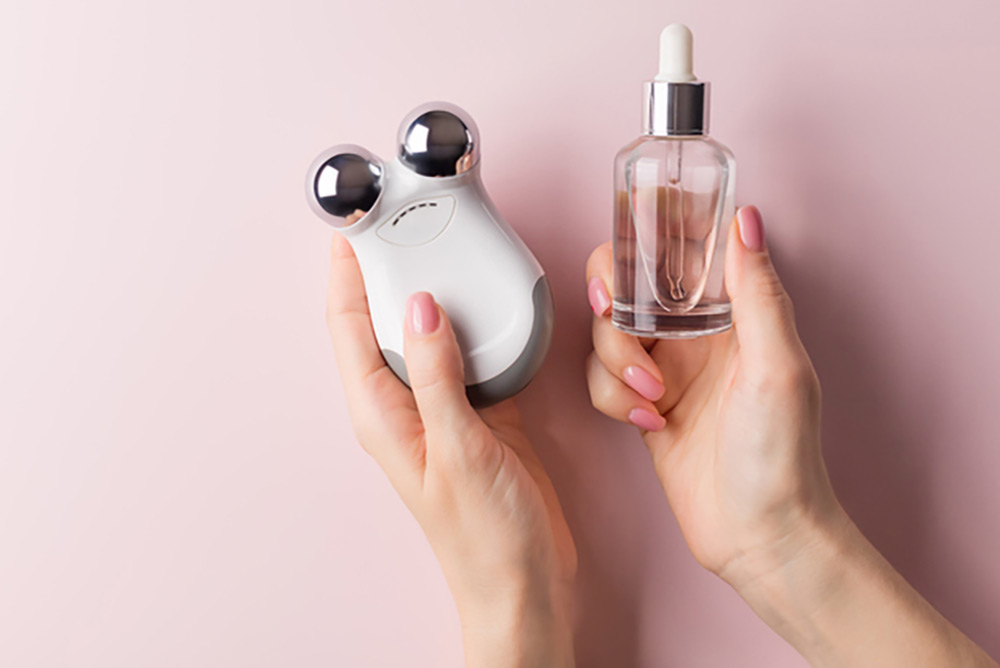By Valerie Monroe
If you’re interested in feeling happier about your appearance—especially as you age—you might like reading what she has to say about it. For more of her philosophical and practical advice, subscribe for free to How Not to F*ck Up Your Face at valeriemonroe.substack.com
ASK VAL:
Q: Have you already discussed microcurrent devices like NuFACE? I’m trying to better understand what their deal is.
A: NuFACE, c’mon.
Maybe FreshFACE? Or HappyFACE? Anyway, thanks for asking what their deal is, because despite the goofy name, I’m curious, too.
I emailed the ever-reliable and knowledgeable HNTFUYF DermDiva, Heidi Waldorf, for her advice. “NuFACE is an over-the-counter, at-home microcurrent device that claims to improve facial contour and skin tone by applying low-level electric current to the skin,” she said. “The first TENS (transcutaneous electrical nerve stimulator) units were developed in the 1970s for pain reduction; there are now numerous FDA-approved home devices for that. But while there’s good evidence that the use of electric current can treat pain, there’s no good evidence that it works for reducing the effects of aging on the skin,” she said.
And here’s a potentially confusing thing: NuFACE is FDA cleared—meaning, Waldorf told me, it can be sold because it’s “substantially equivalent” to something already sold legally on the market. But it hasn’t completed the more rigorous testing required for FDA approval.
As for the product’s promises: NuFACE’s claims of cosmetic improvement are based on limited data showing improved circulation, reduced inflammation, promotion of wound healing, and stimulation of atrophied (shrunken) muscles. Shoring up the claim that the device increases cellular energy? Data from a 1982 study of “energy application” to rat skin. (I confess I don’t know what “energy application” is; but I’m not a rat, so I’m choosing not to look into it today.) And while NuFACE also touts the results of one unpublished clinical study showing improvement in facial contour, tone, and texture after 60 days of daily use in approximately 80% of users, there’s no follow-up after the subjects quit the device. The user guide instructs you to use it for 5 minutes a day 5 days a week for 60 days, and 2 to 3 days a week thereafter.
“I was given one of the original devices years ago,” said Waldorf. “I tried it once or twice, didn’t see improvement, and lost interest, as I’m generally in a rush in the morning and exhausted before bed. I need those 5 minutes to brush and floss.” Waldorf doesn’t regret her decision. She found a physician’s YouTube review showing improvement in facial contour that lasted less than 24 hours even after 2 months of regular use. “This doctor is significantly younger than I am, which may explain why she saw some immediate improvement when I saw none,” Waldorf pointed out. As we age, sagging results primarily from the loss of underlying fat and bone, aggravated by the loss of collagen and elastin—particularly in photodamaged skin. Muscle atrophy plays a lesser role.
Waldorf’s bottom-line? NuFACE won’t hurt you but it won’t provide long-term improvement. If you’re motivated, if you have 5 minutes to spare each morning, if your skin is healthy, and if you don’t have a lot of volume loss, your face and neck may look a little tighter during the day. (Because NuFACE works with an electric current, it’s not safe to use if you have an implantable device such as a pacemaker, are pregnant, or have a seizure disorder.) That’s a lotta “ifs.” And we haven’t mentioned another big one: If you have the moolah—starting at around $400—to invest.
So, if I were presented with the odds of success Waldorf lays out? I’d snap shut my wallet and look into a far less iffy proposition.
Feeling the urge to treat yourself to some electromagnetic stimulation? Talk to your dermatologist about the in-office device Emface, which you can read about here. Better yet, enjoy this free treatment, which I will continue to suggest until someone comes up with a better idea.


